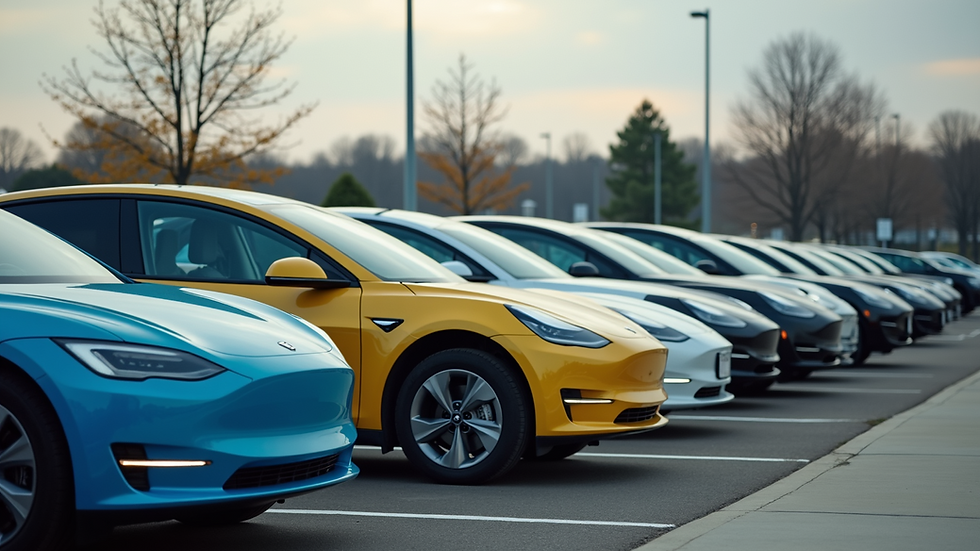Will Used Car Prices Finally Drop in 2025 or Are We Stuck?
- Sunny

- Jul 14
- 4 min read
The used car market has been a wild ride in recent years. Factors like supply chain problems, rising new car prices, and the long-lasting impacts of the pandemic have kept prices high. As we look toward 2025, many potential buyers are asking: Will we finally see used car prices drop, or are we stuck with high costs for a while longer?
In this post, we'll break down what’s affecting used car prices and what to realistically expect in 2025.
Understanding the Current Market
To get a clear picture, we need to examine the used car market as of late 2023. Prices for used cars have shown some stabilization but still remain about 30% higher than pre-pandemic levels. Consider these contributing factors:
Supply Chain Issues: The pandemic created significant disruptions in car production. According to experts, new car production fell by nearly 12% during 2021 and 2022. This shortage drove many buyers to the used car market, causing prices to soar.
Inflation: Rising inflation rates, which reached over 8% in 2022, have squeezed consumer budgets. As a result, even previously affordable used cars are now outside many buyers' price ranges.
Changing Consumer Preferences: With many people hesitant to use public transportation, more are seeking personal vehicles. This shift increased demand for used cars, pushing prices up even further.
Despite these obstacles, there are clear signs that indicate we might be approaching a turning point in the market.
Economic Indicators to Watch
As we move forward, a few economic indicators will be key in determining whether used car prices will drop in 2025. Look out for these important trends:
Interest Rates: The central bank is adjusting interest rates to combat inflation. Higher rates can deter buyers by raising the cost of financing a used car. For example, a 1% increase in interest rates can add about $20 to monthly car payments for a typical used car loan.
New Car Production Recovery: If automakers can ramp up production, supply chain issues may ease. This could drive some buyers back to new cars, reducing demand for used vehicles and ultimately leading to lower prices.
Employment Trends: Job security affects consumer spending. With a steady job market, consumers are more inclined to make significant purchases. If employment rates improve, we might see an uptick in used car sales.
Each of these factors will significantly influence the direction of the used car market throughout 2025.

Consumer Behavior and Trends
Understanding consumer habits can help us gauge potential price changes in the used car market. Here are some key trends to watch:
Desire for Affordability: With living costs on the rise, buyers are increasingly looking for budget-friendly options. This could mean more competition in the lower price ranges of the used car market, potentially driving prices down.
Shifts to Electric Vehicles (EVs): Interest in sustainable transportation is rising. As more electric models enter the market, traditional gas-powered vehicles might decline in value. In fact, EVs currently hold their value better, with some models retaining 60% of their value after three years.
Suburban Relocation: Many are moving to suburbs or rural areas, where personal vehicles are essential. This trend can spike demand for used cars, especially those suitable for families and long-distance travel.
As these consumer behaviors evolve, they will naturally influence demand and pricing in the used car market.
Market Predictions for 2025
While many factors contribute to the direction of the market, experts from the auto industry and economic analysts suggest a mix of optimism and caution regarding 2025:
Gradual Price Corrections: Experts anticipate that used car prices may stabilize or slowly decline throughout 2025. If production improves, we could see inventory levels rise, offering buyers more options.
Increased Variety for Buyers: With a broader selection on the market, buyers might have more power during negotiations. This can foster a more competitive environment with lower prices on certain models.
Impact of New Technology and EVs: The continued shift toward electric vehicles will likely devalue older, less fuel-efficient models. Consequently, while some older traditional cars may see a drop in prices, EVs might retain their value better.
Potential for Incentives: To attract buyers in a changing market, dealerships may offer more promotions. This could influence pricing and help maintain a healthier balance in the market.

Tips for Car Buyers in 2025
If you plan to buy a used car in 2025, keep these tips in mind:
Do Your Research: Stay informed about market trends and check prices regularly. Websites like Kelley Blue Book and Edmunds provide helpful benchmarks for used car values.
Explore Financing Options: Look into different financing solutions and stay aware of interest rate changes. A small shift in rates can significantly impact your overall payment.
Be Patient: If possible, hold off on purchasing until the market stabilizes. Doing so might prevent you from overpaying for a vehicle.
Negotiate: Don't be afraid to negotiate the price. With more inventory expected, there may be room for flexibility, leading to savings.
Looking Ahead to 2025
As we approach 2025, various factors will shape the landscape of the used car market. After a challenging few years dominated by fluctuating prices, signs are pointing toward a gradual market correction. Buyers could soon benefit from better prices and a wider selection of vehicles.
By staying attentive to economic indicators and being patient, you might just find a fantastic deal on a used car in 2025!







Comments